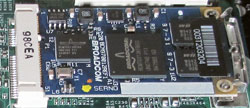« Will industrial tablets benefit from the iPad? | Main | Waterproofing rugged computing equipment »
April 3, 2010
Finally: decent HD video on Atom boxes thanks to Broadcom card
The dirty little secret of millions of Atom N270-based netbooks (and pretty much all other Atom-based systems) is that they really cannot run HD video. If you try it, you get choppy video that creeps along at frame rates of no more than 10 frames per second max even with just 720p video, let alone 1080p. This makes HD video on Atom-based systems impossible to watch. It's a huge disappointment for anyone who thought a "netbook" would surely be able to handle today's high definition media formats, and certainly an annoyance for many customers of vertical market Atom boxes as well.
Well, third party to the rescue. And it's not nVidia (though that company's Ion technology will certainly improve the dire Atom platform graphics situation so that it becomes at least bearable). No, it's Broadcom which offers an inexpensive add-on card that can transform virtually non-existing Atom high-def decoding into something respectable and quite useful.
 The Broadcomm "Crystal HD" High Definition hardware decoder BC970012 with the Broadcom AVC/MPEG-2/VC-1 video/audio BCM70010/BCM70012 decoder chipset is a PCIe Mini Card designed to allow full high definition real-time decoding for hardware that otherwise could not do so. The board can decode H.264 480i/480p, 720p, and 1080i/1080p at 40Mb/second.
The Broadcomm "Crystal HD" High Definition hardware decoder BC970012 with the Broadcom AVC/MPEG-2/VC-1 video/audio BCM70010/BCM70012 decoder chipset is a PCIe Mini Card designed to allow full high definition real-time decoding for hardware that otherwise could not do so. The board can decode H.264 480i/480p, 720p, and 1080i/1080p at 40Mb/second.
I had read about the Broadcom solution last December, but never had a chance to check it out until an Atom N270-based Advantech ARK-DS303 digital signage player arrived at the RuggedPCReview lab. It had the Broadcom module installed as an option, since signage player customers may have a need for high definition video playback.
To test the HD playback capabilities of the Broadcom Crystal HD decoder, I installed both QuickTime and the freeware Media Player Classic HomeCinema 1.3, copied a 250MB 720P high definition Quicktime (.mov) movie recorded on a Bonica HD video camera onto the Advantech player and then ran the movie side by side on an Apple iMac27 and a 22-inch display hooked up to the ARK-DS303, set to 1680 x 1050 pixel resolution. Amazingly, the DS303 kept up with the vastly more powerful iMac throughout the movie, with playback quality being almost identical. There was a very slight choppiness at times, but it did not materially impact playback.
I then ran a full 1080p MPEG4 movie trailer on the DS303 and it never missed a beat. In fact, it almost ran better than 720p video. That is very impressive for a low-power Atom player with just a gig of RAM and no fancy hardware. By comparison, an Acer Aspire One netbook with basically the same hardware as the DS303 sputtered along at just a few frames per second. Our findings are confirmed by this test of the Broadcom card by SilentPCReview.
On a personal level, what this means is that if you have a netbook that has an empty PCIe slot, you can get a Broadcom BC970012 board on eBay or from a company like Logic Supply (see Logic Supply BCM970012), download the drivers from Broadcom (see Crystal HD download page) and finally have decent HD video playback on your little underachiever.
For manufacturers and resellers of rugged tablets and other mobile devices based on the Atom platform, and especially the N270, N280 and the new N450 (and probably the D510 as well), by all means make the Broadcom board available at least as an option! Due to its low cost, the Broadcom BCM970012 PCIe board is virtually a no-brainer for N270/N280 systems, and the newer N450 systems can definitely benefit from Broadcom's follow-up BCM970015.
The video below shows the same 720p (1280 x 720) clip playing on an iMac27 on the left and on the Atom 270-powered Advantech ARK-DS303 with the Broadcom module on the right.
I should mention that the situation is somewhat different for devices based on "Silverthorne" Atom chips, i.e. those with Z5xx Atom processors. Those actually havehard ware support for H.264 and other HD decoding. However, in order to take advantage of that capability, OEMs must include the necessary codecs, or users must run applications that come with those codecs (such as CyberLink or PowerVideo). For example, a Atom Z530-based Fujitsu LifeBook UH900 currently in the RuggedPCReview.com lab easily plays 1080p video at full frame rates.
Posted by conradb212 at April 3, 2010 4:38 PM
















